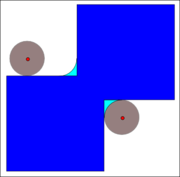
Closing (morphology)
Encyclopedia

Mathematical morphology
Mathematical morphology is a theory and technique for the analysis and processing of geometrical structures, based on set theory, lattice theory, topology, and random functions...
, the closing of a set (binary image
Binary image
A binary image is a digital image that has only two possible values for each pixel. Typically the two colors used for a binary image are black and white though any two colors can be used. The color used for the object in the image is the foreground color while the rest of the image is the...
) A by a structuring element
Structuring element
In mathematical morphology, a structuring element is a shape, used to probe or interact with a given image, with the purpose of drawing conclusions on how this shape fits or misses the shapes in the image...
B is the erosion
Erosion (morphology)
For use of "Erosion" in dermatopathology, see Erosion Erosion is one of two fundamental operations in Morphological image processing from which all other morphological operations are based...
of the dilation
Dilation (morphology)
Dilation is one of the basic operations in mathematical morphology. Originally developed for binary images, it has been expanded first to grayscale images, and then to complete lattices...
of that set,

where
 and
and  denote the dilation and erosion, respectively.
denote the dilation and erosion, respectively.In image processing
Image processing
In electrical engineering and computer science, image processing is any form of signal processing for which the input is an image, such as a photograph or video frame; the output of image processing may be either an image or, a set of characteristics or parameters related to the image...
, closing is, together with opening
Opening (morphology)
In mathematical morphology, opening is the dilation of the erosion of a set A by a structuring element B:A\circ B = \oplus B, \, where \ominus and \oplus denote erosion and dilation, respectively....
, the basic workhorse of morphological noise removal. Opening removes small objects, while closing removes small holes.
Properties
- It is idempotent, that is,
 .
. - It is increasing, that is, if
 , then
, then  .
. - It is extensive, i.e.,
 .
. - It is translation invariant.
See also
- Mathematical morphologyMathematical morphologyMathematical morphology is a theory and technique for the analysis and processing of geometrical structures, based on set theory, lattice theory, topology, and random functions...
- DilatonDilation (morphology)Dilation is one of the basic operations in mathematical morphology. Originally developed for binary images, it has been expanded first to grayscale images, and then to complete lattices...
- ErosionErosion (morphology)For use of "Erosion" in dermatopathology, see Erosion Erosion is one of two fundamental operations in Morphological image processing from which all other morphological operations are based...
- OpeningOpening (morphology)In mathematical morphology, opening is the dilation of the erosion of a set A by a structuring element B:A\circ B = \oplus B, \, where \ominus and \oplus denote erosion and dilation, respectively....
- Top-hat transformationTop-hat transformIn mathematical morphology and digital image processing, top-hat transform is an operation that extracts small elements and details from given images...

